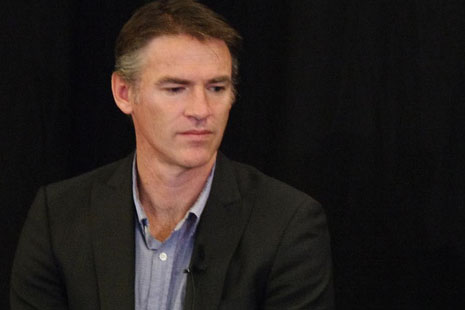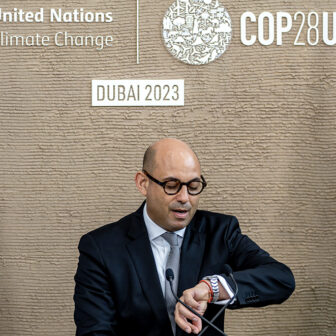IT’s tempting to liken Australia’s climate change debate to an episode of Fawlty Towers: just when you think it can’t get more farcical, it does. Having endured a ridiculous scare campaign about a scheme that is in fact extremely modest, the Australian polity now finds itself embroiled in yet another infuriating debate, this time about whether to scrap the price floor – the legislated minimum price planned for the first three years of the scheme’s floating price phase, starting at $15 per tonne in 2015–16 and rising to $17.05 in 2017–18.
The campaign against the floor, one of the few features that would imbue the scheme with a modicum of integrity, has been led by industry groups emboldened by the extremely low prices for carbon permits in the few significant carbon markets that exist globally. Permits in the EU scheme (which Australia may eventually link to) are trading at around A$10, due largely to the European recession and the oversupply of permits. Carbon credits generated under the UN Clean Development Mechanism, or CDM – the main type of international permit Australian emitters can use for compliance after 1 July 2015 – are currently trading at around A$5 per tonne.
As ANU climate economist Frank Jotzo recently explained, these “rock bottom” prices are set to continue for the rest of the decade:
A massive excess supply from CDM projects already underway or in the pipeline is expected. Until 2020, the amount of unsold excess could be several times larger than the total amount that Europe accepts, and far and away higher than Australia’s maximum demand… The price paid for CDM [credits] can fall well below the cost of the projects – the bulk of the CDM pipeline was conceived at a time when expectations were for sustained demand at prices much higher than now, and almost all the cost of typical CDM projects is incurred at the start. A gap has already opened between prices for EU permits and CDM credits, which are now traded below five dollars per tonne. All indications are that this gap will open more widely.
Similar dynamics have also caused the price of permits in New Zealand’s scheme (under which CDM credits can also be used for compliance, and which may also link to Australia’s scheme in 2015) to plummet to around A$5.
Against this backdrop, Australia’s carbon price will initially be fixed at the much higher level of $23 per tonne in 2012–13, rising to $25.40 by 2014–15. Moreover, entities covered by the scheme are prohibited from relying on imported credits (or “offsets”) during this period. While big emitters are unhappy about this price disparity (they claim, among other things, that it will hurt their international competitiveness), the Australian prices are enshrined in legislation and unlikely to be changed by the current government.
Once the scheme turns into an internationally linked cap-and-trade scheme, however, two things will happen: liable emitters will be able to acquit up to half of their annual emissions liability using international permits and the price of Australian carbon units will be set by the market. The temporary price floor is the only thing that stands in the way of these bargain basement international permits. But the price floor will only come into effect if further regulations are gazetted – and with the government’s slender majority in the lower house in constant jeopardy, the big emitters have seen an opening. They have found a new ally in the form of independent MP Rob Oakeshott, one of the architects of the scheme, who now says he is considering siding with the opposition in a vote to block the regulations. While the Coalition would need the support of one further independent (or Labor) member in order to quash the regulations,* the Oakeshott bombshell has raised the disturbing spectre of a bottomless carbon market.
SCUPPERING the price floor, thus allowing the price to plummet, would be bad public policy for three reasons.
First, by making compliance so cheap and easy, a weak carbon price would fail to induce a structural shift away from our high carbon economy. At $5 a tonne, the price impact of the scheme would barely register on the radars of the big emitters – especially when most of them will receive masses of “transitional assistance” from the government that will further ameliorate the scheme’s impact on their bottom lines. (The most emissions-intensive trade-exposed industries – including aluminium smelting and petroleum refining – will receive 94.5 per cent of their direct and indirect carbon liability in the form of free carbon units in the first year of the scheme, declining by 1.3 per cent per year. With a market price of $5 and a price floor, those industries would face an average carbon price of less than 50 cents per tonne in 2015–16.) Instead of investing in cleaner technologies and production processes to reduce their emissions, many businesses will therefore opt for short-term fixes to meet their liabilities: buying up cheap international offsets as much as they can, while dropping some loose change on Australian carbon units for the remainder.
While Australia’s weak “5 per cent by 2020” emissions reduction target may technically be achieved in this way, the much larger emissions cuts ultimately required in response to climate change will be all the more costly because of the carbon-intensive investments that will continue to be made in the interim.
A second problem is fiscal: the lower the price of Australian carbon units, the lower the revenue from the scheme that will flow into Treasury’s coffers. (Those units not given free to trade-exposed industries and coal-fired power generators are to be sold by the government at auction.) In its modelling of the carbon scheme, Treasury forecasts a $29 carbon price – now seen as wildly optimistic. Climate Spectator’s Tristan Edis compared the revenue implications in financial year 2015–16 of a $4 carbon unit price (that is, based on the expected international price and assuming no Australian price floor) with the Treasury-forecasted $29 price:
Based on backward engineering Treasury’s numbers, they will be auctioning 231.7 million permits in 2015–16. If these only fetched $4, then carbon pricing would only raise $927 million versus current Treasury projections of $6.72 billion – a black hole of $5.7 billion.
Meanwhile, those government compensation and assistance payments associated with the scheme that are not tied to carbon unit value – such as the $1 billion in cash about to be paid to the highest-emitting coal-fired power generators, and the tax cuts and transfer payment increases for households – are fixed liabilities that were (presumably) set on the basis of the $29 carbon price forecasts. The revenue black hole, combined with the fixed liabilities, would put more pressure on the federal budget, leaving much less room for government spending or tax cuts. The $4 scenario, explains Edis, “converts a healthy surplus of $7.5 billion in 2015–16 back into a wafer thin surplus of $1.8 billion.”
The “structural irrelevance” and “fiscal shortfall” problems associated with a floorless scheme combine to produce a third problem: the scheme would lack credibility, rendering its future less certain, which in turn would stifle investment in long-lived assets. The Europeans are grappling with precisely these problems in their own scheme, with many countries trying to find ways to increase the European carbon price. Any half-decent businessperson can see that a pain-free carbon-fest in a floorless Australian market could only go on for so long before the government takes corrective action, tightening the scheme to induce deeper structural change, cut emissions more steeply and raise government revenue. Faced with this uncertainty, the idea of building, say, a new power plant – be it green or brown – becomes overly risky for both project proponents and their financiers, as John Daley illustrated neatly in a classic op-ed from 2009. This underinvestment – a reality in the midst of Australia’s precarious scheme – both raises prices and portends eventual supply shortages.
EVEN pushing ahead with the planned price floor would merely delay the onset of these problems by three years. Only a transparent, long-term, rising price floor and a prohibition on international offsets would substantially overcome them.
But in the design of Australia’s scheme, the objective of global “least cost abatement” has been privileged well above achieving, predictably and stably, long-term structural change, deep emissions cuts and rising government revenue. “International trade in abatement is a legitimate and important element of an efficient global solution to climate change,” asserts Ross Garnaut in his 2011 Review, which was the blueprint of the current scheme. “The eventual transition from a fixed to a floating price, as well as linking with other schemes, will assist in allowing emissions reductions to take place where they are cheapest.”
While Garnaut, and the multi-party committee he advised, accepted the case for an initial fixed price phase, this was always meant to be a temporary, sub-optimal precursor to the supposed wonders of international emissions trading:
In the absence of an effective global agreement, Australia should introduce an emissions trading scheme geared to what others were doing but begin with a fixed price period. We would then be ready to define a target and to float the emissions permit price at some later time, when there were clear rules and opportunities for international trade in permits… In the short term, a fixed price can provide steadiness, when a floating price would be volatile while the scheme remained the subject of fierce political dispute. [Emphasis added]
Garnaut himself did not recommend a price floor at the conclusion of the fixed price phase. In his view, “adequate opportunities for credible international trade in entitlements” would be available by mid 2015. Nonetheless, the stated purpose of the government’s planned price floor – to mitigate the risk of “excessive international price volatility during the first three years of the flexible price period” – is firmly rooted in Garnaut’s concerns about a smooth transition to international carbon trading.
But where is the “effective global agreement”? What of these mature, liquid and stable international carbon markets with “clear rules”? Whither the $29 carbon price? The evidence concerning the trajectory of international climate negotiations and the state of offset markets discussed above strongly suggests that neither a credible global agreement nor mature and effective international markets are likely to materialise within the relatively brief timeframe of the next six years. This should have been plain to Australian policy-makers in 2011 when the policy was designed and these statements were made. The fact that it was not suggests that prevailing beliefs among Australian policy-makers about how global climate action should evolve have clouded their assessments of what is most likely to occur.
Having opted for a “lowest cost global abatement” model of climate action rather than a “structural transformation” model, the government will soon reap what it has sown: an economy plagued by high-carbon economic growth, market uncertainty, electricity under-investment and a fiscal balance sheet obliterated by low carbon scheme revenues and excessive payments of “transitional assistance” to help Australian households and industry cope with a barely existent transition.
Putting in place the planned price floor until only 2018 may not prevent us from becoming the climate policy equivalent of Basil Fawlty – but it is surely the very least we can do. •
Fergus Green is a lawyer and policy analyst specialising in climate change. He writes each month on climate policy issues for Inside Story.




